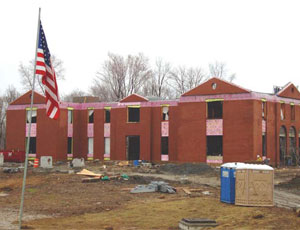... for next to nothing. When things were booming in the city, these firms didn’t come up here.”
Despite the heavier share of small projects, some firms are not shifting strategies. Price says Conti’s tack has been to expand its reach geographically.

“We will look at small projects with the private sector customer that we’ve done business with over the long term,” he says. “But a single small project – a one-time, one-off for somebody we’ve never worked for – we don’t put our resources toward those.”
Price says Conti sees its scale as an advantage, taking on $100 million-plus infrastructure contracts that smaller and mid-sized firms can’t handle. “That’s probably where we fare the best because it really weeds out the competition,” he adds.
Up for Grabs While the small projects market has its share of bigger contractors today, there is a gap between those in it for a quick cash injection and those that keep a steady stable.
Mizzi says Sciame doesn’t focus on project size, but rather the firm’s criteria of highly designed, challenging, architecturally significant work. He cites a new pavilion project at Liberty Island next to the Statue of Liberty that Sciame recently won as an example. It also is doing several jobs under $10 million, he adds.
Conti also has kept a stable of $3 million to $10 million efforts, primarily invite-only environmental remediation, railroad, or security jobs for longtime private sector clients for which it also handles larger projects.
But there are larger firms snapping up smaller jobs just to stay busy. Price says small contractors tell him $10 million jobs that used to get eight to 10 bidders now attract 25. And big contractors sometimes put in no-profit bids. “I’m assuming that they’re just hoping that better days are going to come and they’ll be able to make it up,” he adds. “But when you take a job no profit and you have one little hiccup where you estimated it incorrectly, you’re going to go into the red real quick.”
Smaller firms don’t sport vastly different skill sets to win small projects, but they say they have an edge being closer to the market. For instance, Scully says it’s a lot easier to approach repeat clients for small projects, compared to a big firm swooping in only when the market is tight. “In the slow times, clients will remember and come back to you,” he says.
Smaller firms are also bidding aggressively. “It’s a lot harder to get work – we’re just bidding more,” says Stalco’s Dunathan. “We’re able to keep five estimators busy full time.”
Stalco’s approach includes several recession-driven efforts, including rigorous, pinpoint bidding and estimating efforts. It also asked its employees to each join an industry association and to scout their local neighborhoods for potential projects.
“In September of ’08, we made a decision we weren’t going to fall victim to the economy,” he adds. The firm has managed to not lay off any employees, and just hired a few.

DURELS

PRICE

DUNATHAN
Stalco also approached former clients to inquire about opportunities, and contacted each of its partners, service providers, and vendors and asked them to come up with better pricing. And of course it is seeking new clients, both through public agency bidding as well as a new marketing campaign it is funding in part through a special program in which it is offering its subcontractors early payments at a slight discount – and funneling any saved money into the drive.
These tactics have put the firm on good footing against bigger competitors, Dunathan says. “We used to get blown away by these guys,” he adds. “Now, we’re taking jobs away from them.”
Similarly, Malkin Construction of Stamford, Conn., is picking up additional interiors jobs ranging from a few hundred thousand dollars to $3 million to keep on track, says Thomas Durels, CEO of the firm. It expects that to contribute to a doubling of volume in 2010.
Another smaller firm that has retrenched with success is Del-Sano Contracting of Union, N.J. The firm has asked personnel in the project management and home office ranks to take on extra efforts to conduct deeper preconstruction reviews, scout new projects, and take on additional smaller projects, says Angelo Del Russo, CEO of the firm. “We’re looking at smaller projects, with scopes that we would have turned away before,” he says. “But we’re still making selective decisions.”


Post a comment to this article
Report Abusive Comment